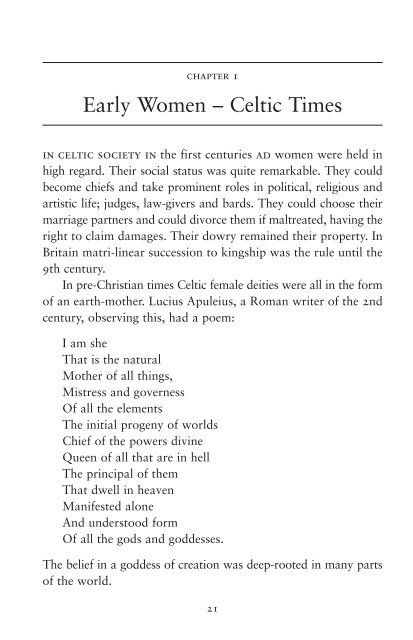Women of the Highlands by Katharine Stewart sampler
What was the crime of the last wich burnt in the Highlands? Which Jacobite lady led men to war while her Hanoverian husband stayed at home? Who were the first Highland women to be recorded in history? And how have wome's lives changed since medieval times? Katharine Stewart takes us to the heart of the Highlands in her history of the women who shaped this land and handed down the legends which have provided a rich vein of material for generations. From the women of the shielings to ladies at court, from bards to conservationists, authors to folk-singers, Women of the Highlands examines how the culture of the Highlands was created and passed down through the centuries, and how the tradition is continuing today.
What was the crime of the last wich burnt in the Highlands?
Which Jacobite lady led men to war while her Hanoverian husband stayed at home?
Who were the first Highland women to be recorded in history?
And how have wome's lives changed since medieval times?
Katharine Stewart takes us to the heart of the Highlands in her history of the women who shaped this land and handed down the legends which have provided a rich vein of material for generations. From the women of the shielings to ladies at court, from bards to conservationists, authors to folk-singers, Women of the Highlands examines how the culture of the Highlands was created and passed down through the centuries, and how the tradition is continuing today.
Create successful ePaper yourself
Turn your PDF publications into a flip-book with our unique Google optimized e-Paper software.
chapter 1<br />
Early <strong>Women</strong> – Celtic Times<br />
in celtic society in <strong>the</strong> first centuries ad women were held in<br />
high regard. Their social status was quite remarkable. They could<br />
become chiefs and take prominent roles in political, religious and<br />
artistic life; judges, law-givers and bards. They could choose <strong>the</strong>ir<br />
marriage partners and could divorce <strong>the</strong>m if maltreated, having <strong>the</strong><br />
right to claim damages. Their dowry remained <strong>the</strong>ir property. In<br />
Britain matri-linear succession to kingship was <strong>the</strong> rule until <strong>the</strong><br />
9th century.<br />
In pre-Christian times Celtic female deities were all in <strong>the</strong> form<br />
<strong>of</strong> an earth-mo<strong>the</strong>r. Lucius Apuleius, a Roman writer <strong>of</strong> <strong>the</strong> 2nd<br />
century, observing this, had a poem:<br />
I am she<br />
That is <strong>the</strong> natural<br />
Mo<strong>the</strong>r <strong>of</strong> all things,<br />
Mistress and governess<br />
Of all <strong>the</strong> elements<br />
The initial progeny <strong>of</strong> worlds<br />
Chief <strong>of</strong> <strong>the</strong> powers divine<br />
Queen <strong>of</strong> all that are in hell<br />
The principal <strong>of</strong> <strong>the</strong>m<br />
That dwell in heaven<br />
Manifested alone<br />
And understood form<br />
Of all <strong>the</strong> gods and goddesses.<br />
The belief in a goddess <strong>of</strong> creation was deep-rooted in many parts<br />
<strong>of</strong> <strong>the</strong> world.<br />
21


















